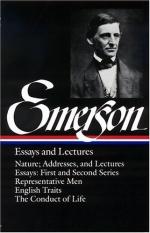|
This section contains 439 words (approx. 2 pages at 400 words per page) |

|
Book 3, Essays - Series 2 : Chapter 10, Essays 1 - 4 Summary and Analysis
These have their own Table of Contents and are listed with roman numerals for ease of identification. The poet opens with a ten line poem in one stanza on one side of the title page and another four lines of poetry on the opposite side. Emerson begins to write using the symbolism of astronomy, astrology, myth, and poetics to describe another aspect of his metaphysical viewpoint. The universe has three children: Jove - Jupiter, Father God, Knower and Pluto - Spirit, Doer and Neptune - Son and Sayer. Emerson views the three of these as equals and each is a sovereign. Neptune is the poet. For the poet, nature is a symbol and so all things are able to function as symbols. He mentions Orpheus and the Bards of...
(read more from the Book 3, Essays - Series 2 : Chapter 10, Essays 1 - 4 Summary)
|
This section contains 439 words (approx. 2 pages at 400 words per page) |

|




